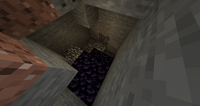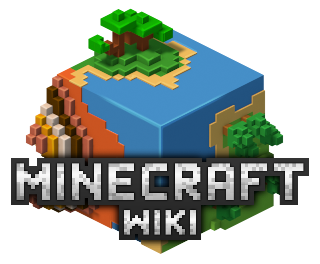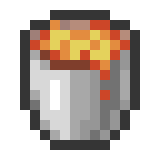| Rinnovabile |
No |
|---|---|
| Impilabile |
Sì (64) |
| Attrezzo | |
| Resistenza alle esplosioni |
100 |
| Durezza |
100 |
| Luminosità |
Sì, 15 |
| Trasparenza |
Sì |
| Infiammabile |
? |
| Prende fuoco dalla lava |
? |
La Lava è un blocco fluido che può essere piazzato dal giocatore solamente usando un secchio. La Lava emette luce e da fuoco ai blocchi vicini ad essa. Nelle mappe generate di recente, la lava è comune nel sottosuolo e nei laghi di lava che si generano occasionalmente nella superficie oppure è presente quasi dappertutto nel Nether.
Presenza in natura
La lava appare sotto forma di grandi piscine sotto il livello 13. Può anche apparire sotto forma di fiume, partendo da un solo blocco-sorgente. La lava è una delle più frequenti cause di morte mentre si è in miniera ed è molto sgradevole perché gli oggetti che il giocatore aveva nell'inventario vengono bruciati. Questo tipo di incidente può essere prevenuto in diversi modi (Non scavare sotto i propri piedi o sopra la propria testa oppure avere nell'inventario un secchio d'acqua). Inoltre nella versione 1.2 sono stati aggiunti dei suoni che indicano la presenza di lava.
A partire dalla versione Alpha 1.2.6, la lava appare anche in laghi sulla superficie. Sono rari da trovare anche se sono presenti ad ogni altitudine e in ogni bioma.
2 blocchi di lava si possono trovare nei Villaggi NPC
Nel Nether la lava è molto comune e può anche sgorgare dalle mura e dal soffitto.
Comportamento
Incendia gli oggetti
I recinti non prendono fuoco anche se hanno lava sopra.
- dopo la 1.9 prerelease, piccole gocce di lava cadono dal soffitto se sopra di esso vi è della lava, questo è un segnale per il giocatore che quindi non scaverà sopra la sua testa. Le goccioline non feriscono il giocatore né producono luce.
- La maggior parte delle entità, inclusi i creatura e i giocatori, subiscono




 di danno ogni secondo di contatto con la lava, inoltre prendono fuoco. Se l'entità tocca l'acqua oppure piove il fuoco si estingue.
di danno ogni secondo di contatto con la lava, inoltre prendono fuoco. Se l'entità tocca l'acqua oppure piove il fuoco si estingue.
- TNT, librerie, foglie, lana, staccionate, legno, e scalini di legno sono infiammabili. Se questi oggetti sono vicini alla lava prendono fuoco. Se la ghiaia cade nella lava prende fuoco, ma il blocco non viene distrutto.
- Le scintille che escono dai laghi di lava sono puramente decorative, non causano danni al giocatore e non incendiano i blocchi vicini.
- Attenzione: anche se si sta giocando in difficoltà pacifica è possibile morire. Ma solo se si è immersi nella lava. Se il giocatore è in fiamme non morirà, poiché i cuori che la lava toglie sono pari a quelli rigenerati automaticamente.
Scorrimento
Nel Mondo principale, la lava scorre per 4 blocchi in ogni direzione. Nel Nether invece, la lava scorre per 8 blocchi in ogni direzione (come l'acqua nell'Mondo principale)
La lava scorre molto più lentamente rispetto all'acqua, e a volte scorre per molto tempo anche se il blocco-sorgente è stato eliminato. Vedere fluidi per avere più informazioni riguardo allo scorrimento.
Interazioni fra lava e acqua:
- A partire dalla versione 1.9, se la lava scorre sopra all'acqua, si crea la pietra.
- Se la lava scorre orizzontalmente nell'acqua, si crea il pietrisco.
- Se la lava scorre orizzontalmente nell'acqua, si sente un suono, ma non si forma nessun blocco.
- Se l'acqua scorre sopra la lava viene creata l'ossidiana. La lava viene distrutta durante il processo, così la Pietra non può essere generato.
- Se durante la caduta verticale l'acqua tocca la lava, l'ossidiana verrà creata, anche se l'acqua non ricopre completamente il lago di lava.
La principale fonte naturale di ossidiana sono i fiumi che scorrono sulla superficie delle pozze di lava nelle grotte profonde. Si deve prestare attenzione durante l'estrapolazione, dal momento che solitamente sotto l'ossidiana è presente uno strato di lava.
La lava che sta scorrendo, sul suo percorso distruggerà: grano, fiori, funghi, leve, entrambi i tipi di torce, cavi di pietrarossa e binari. Notare che non scorre sopra le pedane a pressione, staccionate, o tutti i blocchi di legno o lana. Le canne da zucchero bloccano la lava, ma se viene distaccata dalla sua sorgente d'acqua verrà distrutta.
Se la lava cade sul cavo di redstone delimitato dall'acqua, la redstone si trasforma in ossidiana senza la perdita di lava. Viene considerato un bug, comunque Notch ha detto che rimarrà per diventare una feature;[1] see the section on Obsidian for more information.
Using a redstone wire, a one-block lava flow can be redirected by supplying power to the spring block, which will cause it to reset the flow towards the now-nearest terrain depression. This is further elaborated in this thread (only viewable when logged-in). It cannot, however, be reversed. This re-calculation is made because redstone wire when toggled changes the block from redstone(on), to redstone(off). Whenever a block updates on any side of lava, the lava re-calculates where to flow, but does not cut off its current direction of flow.

If there is lava flowing above a block, the lava seeps through.
If there is a body of lava flowing above a block, the lava visually seeps down through the host block. This "dripping" effect also applies to Water, although water droplets seep through at a much faster rate. These droplets are purely aesthetic and will not affect the player or other blocks in any way.
Infinite Lava Duplication
In 1.9pre5, infinite lava could be made much the same as infinite water. When placing 4 source blocks of lava to the sides of an empty space in a + shape they will flow into the middle creating another source block of lava. In 1.9pre6 infinite lava springs cannot be used as a renewable resource.[2], and as of Minecraft 1.0 lava sources can no longer be duplicated.
- It should be noted that virtually infinite flowing lava can be created, limited only by the height of the world. However only the original lava block can be collected.
In the ported version for XBox, lava (as of 5-20-12) can be easily duplicated in the following manner. A 2x1 depression is mined out of dirt, and a bucket of lava is poured against the back "wall" of the depression. Once the lava begins to glow, it can be scooped back into the bucket. After a few frames, the lava will reappear in the depression while also being in the bucket. Both are source blocks that can be placed and collected. It should be noted that occasionally this method just destroys the source block. However, the majority of times it duplicates it, so as long as there are enough sources, the odds are in your favor.
Secchio di lava
Puoi raccogliere e piazzare sorgenti di lava usando un Secchio. Come con l'Acqua, puoi solo raccogliere le sorgenti, non il flusso di lava che viene da esse.
Lava can be used to make obsidian, to light an area, or to create traps. When used to create obsidian, water will be used to cool the lava either before collecting it with a diamond pickaxe in a mold in the desired shape, or by emptying the bucket next to an artificially created waterfall.[3]
Lava can be placed in a furnace in a bucket to be substituted for coal. Its burning time is 1000 seconds, compared to 80 seconds for coal (100 smelts vs. 8). Using a lava bucket as a fuel source consumes the lava and, as of snapshot 12w22a, leaves an empty bucket. In earlier versions, both the lava and the bucket were consumed.
Lava can also be used as a garbage disposal, by creating a 3×3 box of any non-flammable block and leaving a 1 block gap inside. Pour lava into it and drop unwanted items.
or
It can also be used as a light by using glass as the wall. It is also a good idea to have a contained water spring next to it, or to carry a bucket of water.
Lava bucket as a weapon
Lava buckets are one of the most destructive weapons at the player's disposal:
Pros
- Infinite uses, no durability.
- Large area of effect, depending on terrain.
- Slows down the mobs.
- Also acts as lighting.
- Can be used as a trap.
- Fast, almost certain kill.
- Can help players keep a distance from hostile mobs.
- It won't make Endermen hostile (unless you look directly at them).
Cons
- Just as dangerous to the player, usually deadly if water is not near. To avoid this downside drink a potion of fire resistance.
- Takes long time to flow.
- Usually destroys the loot.
- Can take a long time to disappear, potentially blocking your escape route.
- Does not yield EXP.
- Since Nether Mobs are fire-resistant, lava will not harm them.
Lava molding
Lava can be combined with water for molding Obsidian, Stone or Cobblestone structures of any size when used properly:
Pros
- One does not need to contain lava on all sides; lava flowing freely down is often used.
- The size of structures is almost limitless (the sky IS the limit). Many structures are massive.
- Lava molding can have very desirable architecture, mostly from downward flowing lava.
- With only a few starting blocks, one can build very massive structures.
- Lava molding is much faster than building by hand (this is limited to larger structures).
Cons
- Lava molding can be very dangerous to players and other entities alike.
- If one is not careful, they may solidify the source block, creating obsidian.
- One is often limited to walls and towers.
- Structures can only be made from either stone (which is harder to get), obsidian, or cobblestone.
History

Magma at the bottom of the map in Classic

The same area as above, with water flooded in and bedrock exposed.
Classic
At first lava had a different texture File:Lava-Pre Creative 0.0.19a.png, but then changed to the current texture. The old texture can still be found in the terrain.png file at the minecraft.jar. In Classic, lava spreads by duplicating itself to open horizontal and downwards squares like Water. Lava is slower, though, and can be easily outrun. A quick player can block the flow of lava by building a dam. However, if the lava wave is large, a player may not be able to build fast enough. Also like water, lava slows down the player moving through it but it does so to a greater extent, and swimming through it causes greater damage. Lava is also more opaque than water and is harder to see through while you are submerged; you cannot see through lava from outside it. At the bottom of the map, magma can be found directly above bedrock in a different form, as it will trap the player and prevent the player from leaving unless water is let in and collides with it or if the player places a sand or gravel block, letting it drop into the magma. If water is let into the area where the magma is, the magma will form Stone, allowing the stone block to be removed to expose Bedrock underneath.
Survival
Since Infdev, lava flows more realistically across surfaces but not as much as water does. Lava will flow for a total distance of 3 blocks "away" from the source block (7 in The Nether). Just like water, lava will flow in a single line towards the nearest terrain depression within four blocks. Items thrown into lava flows will disintegrate. All objects burn instantaneously when dropped into lava. Fired arrows will not disintegrate, but will appear to catch fire and can still be picked up.
Magma is no longer present at the bottom of maps in this mode. Lava can melt ice and snow (but not snow blocks), much like torches can, but melt a larger area. Lava is luminous and a large lava flow is visible in the dark from quite a distance.
Since the Classic 0.0.19a client update on June 20, 2009, Lava's texture became animated.
The creation of Obsidian was added in Alpha v.1.0.6_03.
In Beta, lava is less reactive with horizontal water flows.
Since the Seecret Friday Update 9, buckets of lava can be used to fuel a Furnace for 100 smelts. Please note that you will not get the bucket back. So unless you have a sufficient amount of iron, this method is not recommended. (As of Snapshot 12w22 you will get the bucket back)
Before the December 3rd update , right-clicking a furnace/workbench/chest while holding a lava bucket would leave you with a lava spring on top of the said item, but now it just opens the inventory as it would have if you were carrying nothing.[4]
As of Beta 1.8, when lava is touched by rain, it emits smoke (but does not transform into another block).
Before the 1.9 prereleases, source blocks used to be unable to be duplicated over an area deeper than 1 block. Jeb said that this was a bug and is now fixed.
As of the 1.9 pre-release, if there is a body of lava flowing above a block, the lava visually "drips" down through the holding block.
As of 1.9 Prerelease 5, lava source blocks are destroyed when completely surrounded with TNT.
As of snapshot 12w05a, lava (as well as the embers that pop out of it) makes sounds. These sounds were in the game files for a long time but they had not played in-game.
Trivia
- "Lava" is called Lava once it reaches the surface, and is called Magma when underground. As such, most of the molten rock in Minecraft is actually Magma, but for the sake of simplicity, all of it is called lava.
- A water source block placed 1 block away upwards diagonally (but not through corners) from a lava block will first flow in the direction of the lava, then other directions facing away from the lava. This happens because water physics treat the place that lava occupies as empty, and try to flow to it. Once the water turns the lava into obsidian, the water physics update to flow in all directions.
- Lava can be contained by surrounding it with snow blocks, because they are not flammable and do not melt.
- It is a common misconception that underground lava pools cause more minerals to spawn. The idea arrives from the fact that the large open area leaves more of the nearby natural minerals exposed. If anything, the air pockets associated with lava pools actually reduce the chances of minerals spawning by taking away natural rock space.
- Above-ground lava lakes seem to generate most often in Taiga biomes
- An easy way to 'fill-in' large pools of lava is to use gravel or sand, which will fall to the bottom of the pool and stack upwards.
- You can see the stars when in lava, even if it's supposed to be opaque.
- If an item falls into the edge of a lava pool, it may pop back out and appear as if it were burning. Also, you can pick the item back up once it's back on land. Occurs more commonly in SMP.
- Although lava is a liquid, it is not possible to drown in lava. This applies to all mobs.
- Unlike water, lava does not stop a player's fall.
- Arrows shot by the player will only catch fire if shot in flowing lava and not still lava.
- Very rarely, lava is able to continue flowing after it's source block is removed and create another small source block and continue flowing.
- Lava CAN be used for fuel in the furnace and can smelt a little more than 1.5 stacks of ore/material, but the bucket will not be returned (Unless you are using snapshot 12w22a or later). (1.5 stacks = 96; actual smelt is 100.)
- You cannot put 4 blocks of lava in a 2x2 square to create an infinite source of lava like you can with water, even in the Nether.
- End Portals can be seen yellow if exposed to the surface when you are in lava.
Bugs
- In taiga biomes, lava will occasionally freeze while near but not touching water, and will form obsidian or cobblestone.
- Lava can still be blown up by TNT. It has happened but it turned into flowing lava then got blown up.
Galleria
- LavaLake2.png
Un lago di lava trovato direttamente sulla superficie del mondo.





